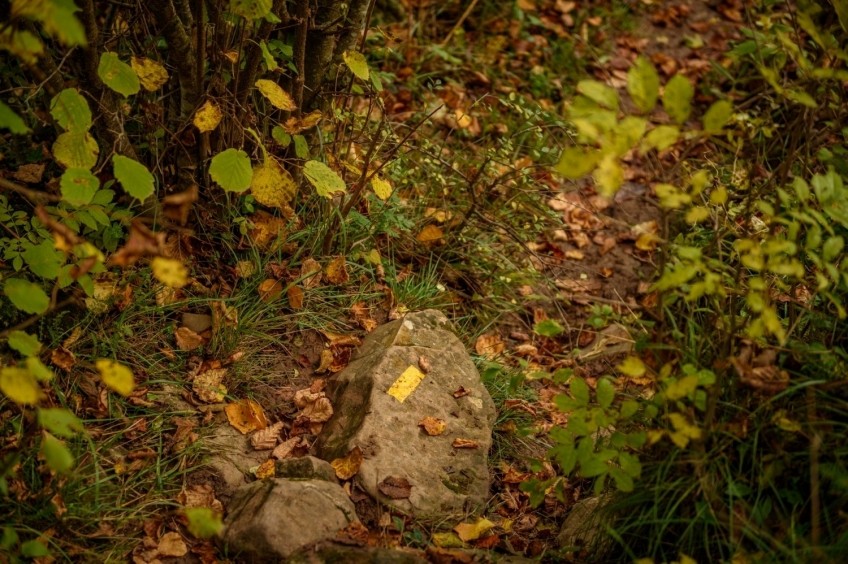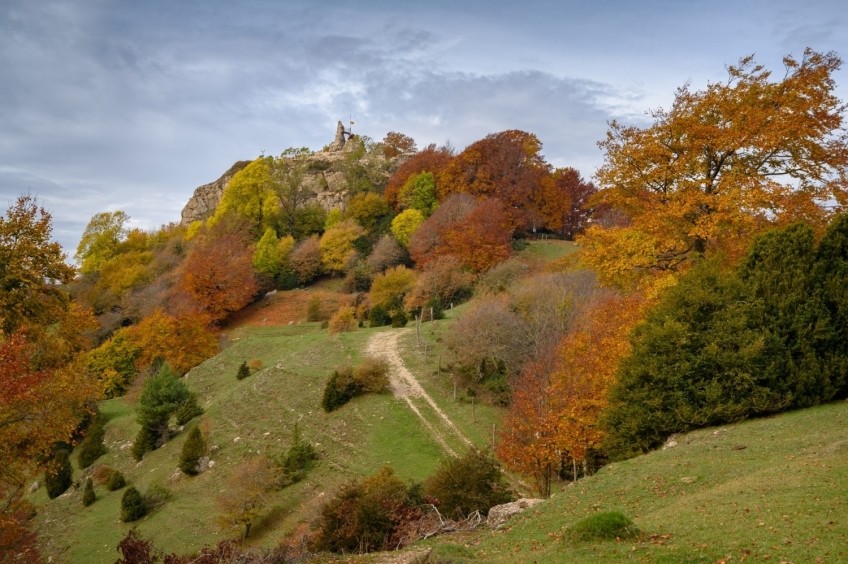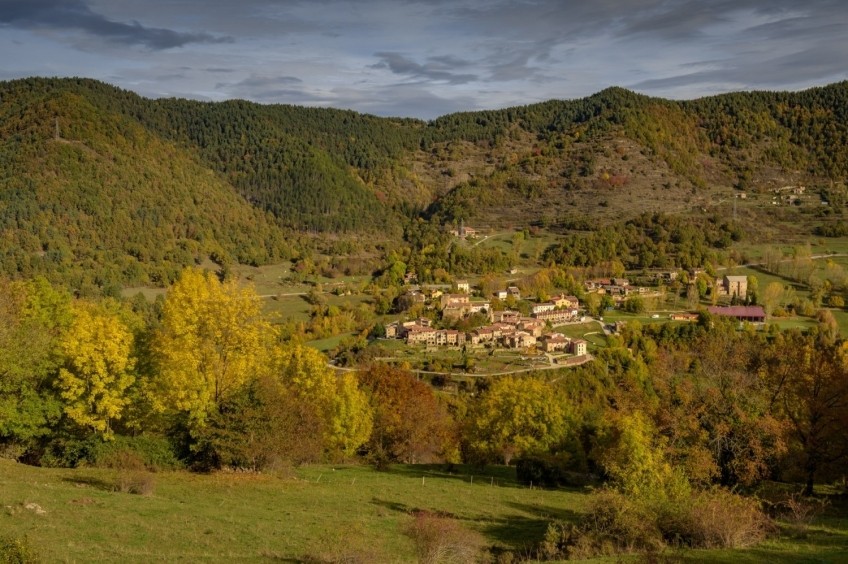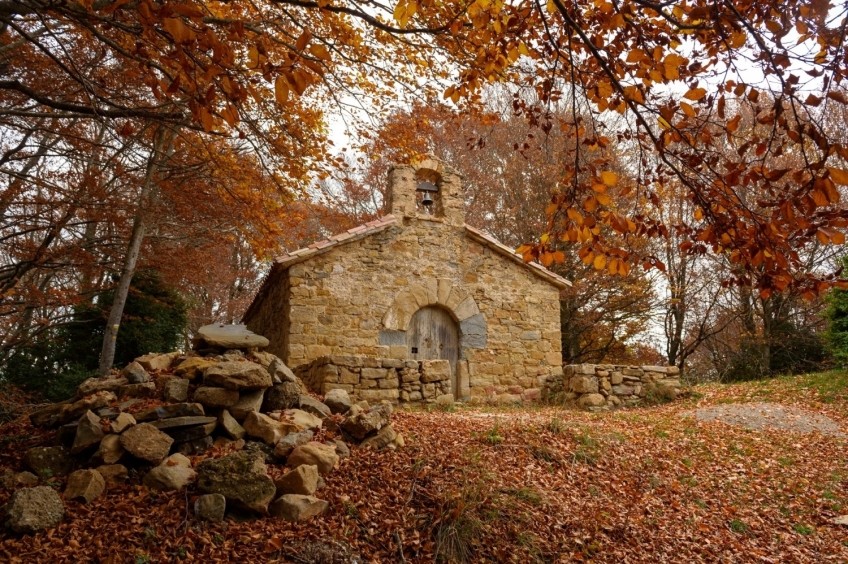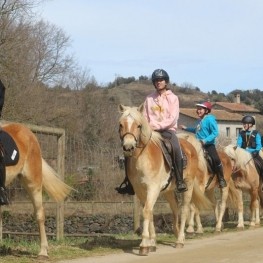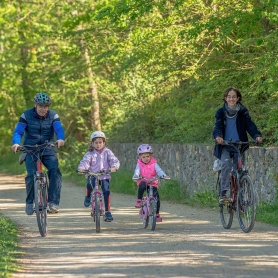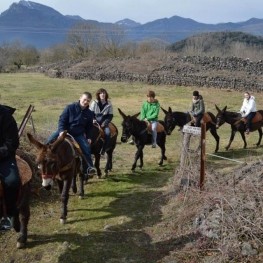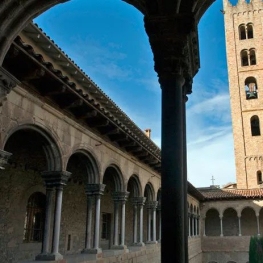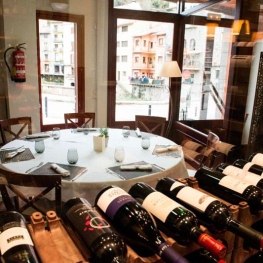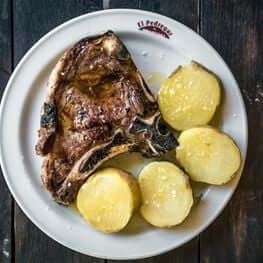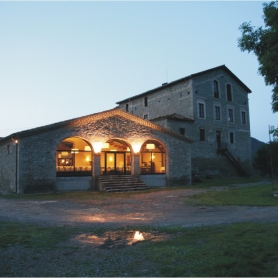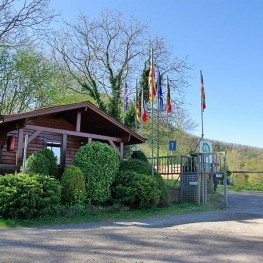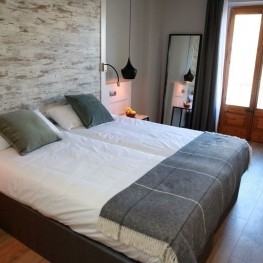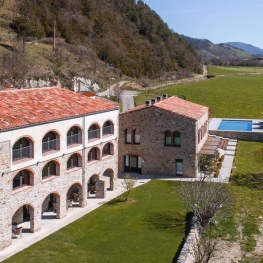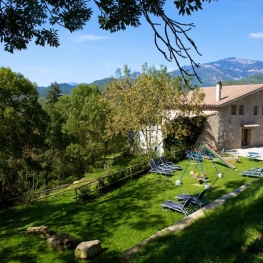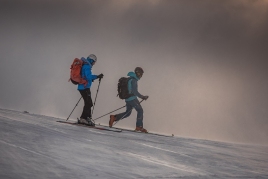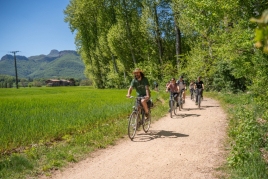Milany Castle from Vallfogona de Ripollès
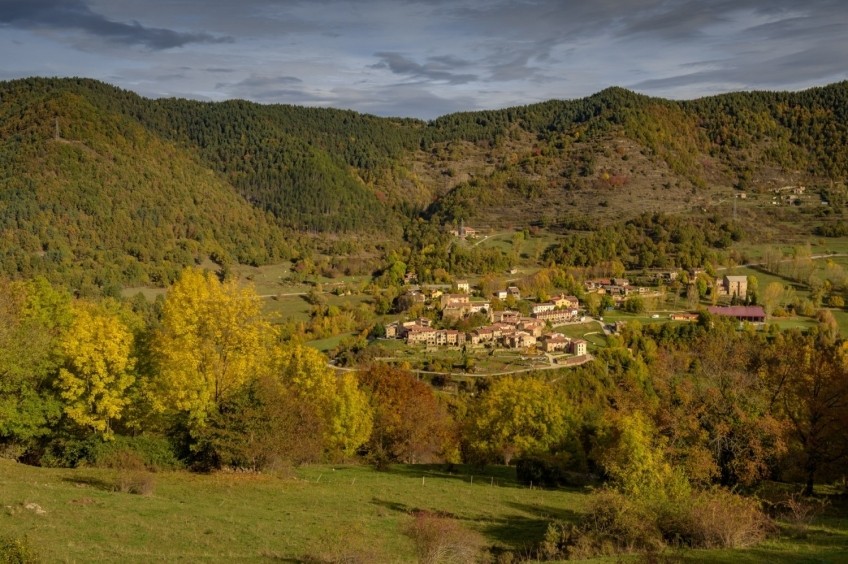
The Sierra de Milany is a great unknown for the general public. Proof of this is that practically we will not find anyone doing this route and that some paths are not well trodden. This is precisely the grace of this mountain range: kilometers and kilometers where the beech tree is the lord and master of a hidden corner of the Pre-Pyrenees. A great excursion to do in the fall.
Difficulty: moderate. The main difficulty is orientation when the leaves fall. All the way is well marked with GR and PR signs, although at some points it will be good for us to check the GPS.
Elevation: 544 m
Time: between 5 and 6 hours according to rhythm and stops
Kilometers: 16.8 km
Variants: An alternative for the descent would be through the Fuente de la Tosca and the Torrent de la Masica. So drain off the turn quite a bit. Like other options, you can reach the Castillo de Milany by the southern slope from Vidrá or Llaés, or from a track that approaches us.
Access: We arrive at Vallfogona by the N-260a that goes from Ripoll to Olot to Vallfogona and the Coll de Canes. We leave the car in the center of Vallfogona and start walking from the town towards the medieval bridge of Vallfogona.
We start the route in the direction of the Milany Castle. During the ascent, we will follow the GR-3 / GR-151.1 signs, one of the Abad Oliba Paths. We will start but going down to the Medieval Bridge to cross the Riera de Vallfogona.
On the other side of the bridge, we turn right (a signpost points us to the Castillo de Milany 6 km away). We continue along a very pretty stretch of paved road, between boxwood and hazelnut trees. The path goes up and we gain height quickly through the forest. We will always follow the GR and yellow marks that will be especially useful in some meadows where there are other cow and cattle trails. We crossed several cattle fences (let's count to 7), and we also crossed a forest track. From here, we already have a magnificent view of the town of Vallfogona and the entire valley. Soon we found another track with a signpost.
We now continue for a long half hour (2.5 km) along the forest track that rises much more gently. This track, according to the ICC, is called Camino del Bac de la Portella. The path skirts La Portella and faces south. Progressively, we leave the red pine forest and we enter towards the beech forest, increasingly lush. Around Todos los Santos it has incredible ocher tones.
After a curve in the track at the Torrent de Can Cuc, we leave the track and go up to the left along a path that goes up the side of the canal (we will find signs of the GR). During the ascent along the path, we will cross several old forest tracks. This section is all beech with boxwood undergrowth.
After about 20-30 minutes we will reach another forest track where we turn to the right, heading west and go up the side of the track to avoid making more turns. Finally, we find a path that goes up to the Cuello de Milany where we reach the end of the ridge.
From this point we can already see the Castillo de Milany, now we only need to finish crowning this peak, passing by the side of the track and making a small climb where a couple of pins will help us to put our hands if necessary. From the castle (undergoing restoration works as of 2019), we go up to the tower's viewpoint from where we will see perfectly all the Pre-Pyrenees from Garrotxa to Pedraforca, apart from all the Ripollès and the beech trees that line the surroundings. To the south, the summits of Montseny and Bellmunt stand out.
We descend from the castle and return to Coll de Milany along the track. Now we will continue practically all the time along the ridge to Santa Magdalena de Cambrils. Immediately, we leave the track and take a path to the left. From now on we will only look at the PR-C 59 marks that will take us to Santa Magdalena de Cambrils in a matter of 1h 15 approximately.
During this section, we will pass several fences of the cow yarns and we will alternate sections of meadows and sections of beech forest. The forest covers a good part of the views, but it will allow us to enjoy a magnificent environment and in silence.
Progressively, the path is blurred by the effect of the beech leaves, especially in autumn. We go down to the neck of the Espinal where a power line passes. We cross the neck and continue, now uphill, until we recover the ridge line, slightly on the southern slope. In the meadow sections, we will have to pay attention to the markings so as not to lose our way.
We pass through the Trevija neck and finally arrive at Santa Magdalena de Cambrils, a small hermitage on top of a hill. The environment of the beech forest is very beautiful. An indicator sign marks the various routes to get here: from Collfred, Vidrà, etc. We will continue towards the Vallfogona which marks 2h30 '.
From the hermitage, we go back, cross a fence and go down a path in a Northwest direction, indicated with PR marks. The road goes down quickly. We cross a forest track and, further down, we come to another forest track that we will follow for about 300m towards the Northwest. At a curve, we will take a path (marked with milestones and PR signs) and we go down towards the North until the Plan de Puigvassall. At this point, we turn left along a track to the Puigvassall house.
When we get to the house, we go around it to the right and we continue along the path that plans and goes down towards the North. It is important not to deviate on any of the trails near the house: we are going to look at the PR marks and purple spots.
In about half an hour we will reach the bottom of the valley, on the concrete track that the Camping Mas La Bauma. We follow it a stretch and further down we turn left. We pass some camping cabins and continue along the trail, descending gently. From here we could continue directly along the track to the town. We follow it for a section, but then we take the PR path that goes down until we cross the Riera de Vallfogona and you will find the track right next to the stream. In this way, we make a bit of a shortcut. Finally, we reach the town by track and complete this interesting circular route.
Authorship of photographs and text: Sergi Boixader
What to do
Granja de cavalls i ponis, eQuillet
La Vall d'en Bas (a 13.8 Km)At the eQuillet Equestrian Club, we offer a wide range of activities…
GARROTXA amb Bici
Olot (a 14.8 Km)GARROTXA amb Bici, (previously known as "Centre Logístic de Bicicletes") is a…
Rucs i Someres
Les Preses (a 14.2 Km)Rucs i Someres is dedicated to organizing tourist rides on Catalan donkeys…
Terra de Comtes i Abats a Ripoll
Ripoll (a 9.3 Km)Terra de Comtes y Abats offers you a lot of proposals to…
Where to eat
Restaurant el Pont 9
Camprodon (a 13.7 Km)A restaurant serving humble and simple cuisine, where you can enjoy the…
La Santa Restaurant
Ribes de Freser (a 15.8 Km)Our fires cook locally sourced food, harvested using traditional methods. We support…
Braseria Les Comes
L’Esquirol (a 17.9 Km)Located on the premises of the Anigami Adventure Park, they offer menus…
Restaurant Dachs
Les Llosses (a 16.5 Km)Restaurant Dachs offers versatile spaces for celebrations in Les Llosses, with rustic…
Where to sleep
Càmping les Preses Natura
Les Preses (a 14.6 Km)Camping Les Preses Natura, located in the Natural Park of the Volcanic…
Hotel Cims de Camprodon
Camprodon (a 14 Km)The Hotel Cims Camprodon is located right in the center of Camprodon,…
Hotel Rural Les Planes del Grau
Sant Joan de les Abadesses (a 5.8 Km)Enjoy a rural hotel with a sober and minimalist design but at…
El Serradal
Sant Joan de les Abadesses (a 5.5 Km)Relax in a natural setting of meadows and forests, enjoying walks, hikes,…

